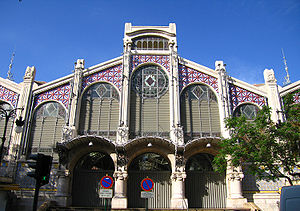Mercado Central, Valencia
| Mercado Central, Valencia | |
|---|---|
| Native name Spanish: Mercado Central de Valencia | |
 | |
| Location | Valencia (Valencian Community) |
| Built | 1914-1928 |
| Architectural style(s) | Valencian Art Nouveau |
| Type | Non-movable |
| Criteria | Monument |
| Reference no. | RI-51-0008309 |

Mercado Central or Mercat Central (English: Central Market) is a public market located in across from the Llotja de la Seda and the church of the Juanes in central Valencia, Spain. It is one of the main works of the Valencian Art Nouveau.
History
In 1839, the spot had been used to inaugurate an open-air marketplace called Mercat Nou. By the end of the century the city of Valencia sponsored a contest for the construction of a new roofed market. A new contest in 1910 selected the present design by Alejandro Soler March and Francisco Guàrdia Vial, who had trained at the School of Architecture of Barcelona and collaborated with Luis Doménech Montaner. Construction began in 1914 and was not fully completed until 1928 by the Valencian architect Enrique Viedma Vidal.
The Central Market of Valencia is one of the largest in Europe, covers more than 8,000 square metres, over two floors, with a predominantly Valencian Art Nouveau style. Its unusual roof comprises original domes and sloping sections at different heights, while the interior seems to be lined in a range of materials such as iron, wood, ceramics and polychromed tiles. The beauty of the building stands out especially on account of the light that enters through the roof at various points, and through coloured window panels.[1]
The style blends a modern Valencian Art Nouveau style but mirrors some of the architectural influences of nearby buildings such as the Valencian Gothic style Llotja de la Seda and the eclectic Gothic-baroque church of Sants Juanes. It celebrates the power of iron and glass to permit the construction of large open spaces, but still utilizes domes at crossings.[2]
Most vendors sell food items, although souvenir shops and restaurants are located inside the market as well. It is a popular location for tourists and locals alike.
References
- ^ Central Market of Valencia Turespaña, Spain National Tourism Agency.
- ^ Official Website, history.
External links
- Website of the Central Market of Valencia
- Central Market of Valencia Turespaña, Spain National Tourism Agency.
- Valencia Tourism
